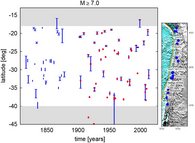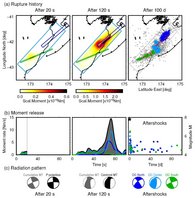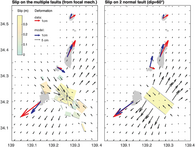Archiv Highlights 2017
Complex rupture process of the Mw 7.8, 2016, Kaikoura earthquake, New Zealand, and its aftershock sequence
Cesca, S., Zhang, Y., Mouslopoulou, V., Wang, R., Saul, J., Savage, M., Heimann, S., Kufner, S., Oncken, O., Dahm, T. (2017)
The 2016 M7.8 Kaikoura earthquake, one of the largest ever instrumentally recorded earthquakes in New Zealand, produced distributed uplift (peak amplitude of ∼8m), large horizontal coseismic displacements along several discrete active faults and diffuse aftershocks. The seismic waveforms’ expression of the main shock indicate a complex rupture process. A key question of global interest is to shed light on the mechanism with which such a complex rupture occurred, and whether the underlying plate-interface was involved in the rupture; seismic hazard for such a distributed, shallow faulting is important to be assessed. We jointly invert regional and teleseismic seismograms, GPS and InSAR, to determine the rupture process of the main shock and moment tensors of 118 aftershocks, suggesting the sequential activation and slip distribution on at least three major active fault domains. The rupture nucleated as a weak strike-slip event along the Humps Fault, propagated northward onto a shallow reverse fault, and finally onto a strike-slip fault at the northern end of the rupture. In our model, the low angle splay thrust fault is located above the slab and connects the strike-slip faults kinematically.
| Earth and Planetary Science Letters, 478, pp. 110-120. |DOI: http://doi.org/10.1016/j.epsl.2017.08.024 |
A nonplanar slow rupture episode during the 2000 Miyakejima dike intrusion
Cattania, C., Rivalta, E., Hainzl, S., Passarelli, L., Aoki, Y. (2017)
Magmatic intrusions release extensional strain in the Earth's crust upon availability of magma. Intrusions are typically accompanied by earthquake swarms and by surface faulting that is often larger than what is expected from the magnitude of the induced earthquakes. The 2000 Miyakejima dike intrusion triggered the largest volcanic earthquake swarm monitored so far, with five Ml>6 earthquakes. We analyze the seismicity and deformation induced by the Miyakejima dike with the aim of constraining the timescale and mechanisms of slow strain release during the episode. In six earthquake bursts lasting few hours and migrating at ∼1 km per hour we find candidates for slow earthquakes. We analyse the migration of seismicity in the bursts, their focal mechanisms and the deformation occurring in the same time frame. Deformation is best explained by aseismic slip (in addition to the seismic burst), with a moment 1.3 to 2.3 times larger than the earthquakes' seismic moment, and some opening on the dike. The aseismic slip occurred over a few hours, with moment, duration, and migration velocity consistent with that of previously observed slow slip events. We argue that the seismic bursts are likely driven by slow slip, sharing most properties with tectonic slow slip events and swarms, but occurring on a set of nonaligned faults.
|Journal of Geophysical Research | DOI: http://doi.org/10.1002/2016JB013722 |
Testing stress shadowing effects at the South American subduction zone
F. Roth, T. Dahm, S. Hainzl (2017)

The seismic gap hypothesis assumes that a major earthquake is followed by a long-period with a reduced occurrence probability for the next large event on the same fault segment, as a consequence of the induced stress shadow. To test this basic recurrence model we analyze one of the best available data sets, namely the historical record of 174 major earthquakes between 1520 to 2015 along a 3000 km long linear segment of the South American subduction zone, and relax the tide model assumptions of previous studies.
We find that the gap model cannot be verified and that earthquakes are best explained with random process, although some tendencies for clustering and weak quasi-periodicity is observed for the largest earthquakes with magnitudes M>8.
We perform simulations of a physics-based stochastic earthquake nucleation to understand the apparent failure of the earthquake recurrence model. This shows that simplified gap models, ignoring the complexity of the stress transfer to neighboring segments and the heterogeneity in stress drop, cannot be applied for forecasting the M>7 earthquake occurrence at this plate boundary.
| Geophys. J. Int. 211, 1294-1305, 2017 | DOI: http://doi.org/10.1093/gji/ggx362 |
New magma pathways after giant lateral volcano collapses
Maccaferri, F. , Richter, N. , Walter, T. R. (2017)
Giant lateral collapses are huge landslides occurring at the flanks of a volcano. Giant lateral collapses are rather common events during the evolution of a large volcanic edifice, often with dramatic consequences such as tsunami and volcano explosions. These catastrophic events interact with the magmatic activity of the volcano, as a new research in Nature Communications suggests. Giant lateral collapses may change the style of volcanism and the chemistry of magma, and as a new study by GFZ scientists reveals, also affects and diverges the deep paths of magmas. New volcano centres may form at other places, which the scientists explain by studying the stress field changes associated with the lateral collapse.
In the study entitled “The effect of giant lateral collapses on magma pathways and the location of volcanism”, authored by F. Maccaferri, N. Richter and T. Walter, all working at GFZ, in section 2.1 (Physics of earthquakes and volcanoes), the propagation path of magmatic intrusions underneath a volcanic edifice has been simulated by means of a mathematical model. Computer simulations revealed that the mechanical effect on the earth crust resulting from a large lateral collapse, can promote the deflection of deep magmatic intrusions, favouring the formation of a new eruptive centre within the collapse embayment. This result has been quantitatively validated against observations at Fogo Volcano, Cabo Verde.
A broader view to other regions reveals that this shift of volcanism associated with giant lateral collapses is rather common, as observed at several of the Canary Islands, Hawaii, Stromboli and elsewhere. This study may have implications particularly for our understanding of the long term evolution of intraplate volcanic ocean islands and sheds lights on the interacting processes occurring during growth and collapse of volcanic edifices.
Original study: The effect of giant lateral collapses on magma pathways and the location of volcanism
Nature Communications, DOI: http://doi.org/10.1038/s41467-017-01256-2




